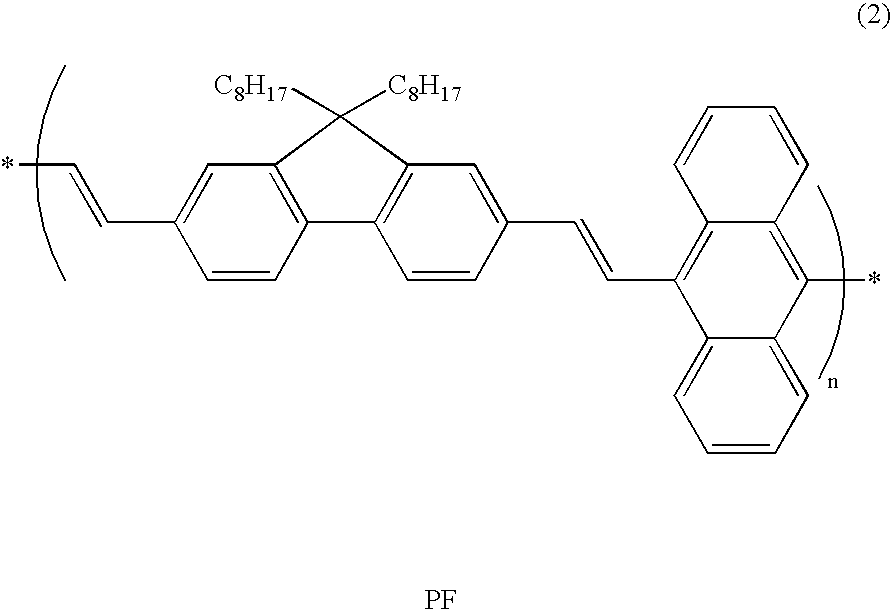Organic electroluminescent element
a technology of electroluminescent elements and organic elements, which is applied in the direction of luminescnet screens, discharge tubes, instruments, etc., can solve the problems of oxidation of the electroluminescent layer, deterioration of emission characteristics, and inability to obtain high-quality image display, etc., to achieve low oxidation of characteristics, high reliability, and high efficiency
- Summary
- Abstract
- Description
- Claims
- Application Information
AI Technical Summary
Benefits of technology
Problems solved by technology
Method used
Image
Examples
example 1
[0087] As a base material, a 40 mm×40 mm-transparent glass substrate (non-alkali glass NA35, manufactured by NH Techno glass Corp.) having a thickness of 0.7 mm was prepared, after the transparent glass substrate was washed according to a standard process, a thin film of Ag (100 nm thick) was deposited by a magnetron sputtering method. When the thin film of Ag was formed, Ar was used as a sputtering gas, a pressure was set at 0.15 Pa, and a DC output was set at 200 W. Next, on the Ag thin film, in order to give a role of accelerating hole injection, a thin film (30 nm thick) of indium tin oxide (ITO) was formed by use of a magnetron sputtering method. In the formation of the ITO thin film formation, a gas mixture of Ar and O2 (volume ratio Ar: O2=100: 1) was used as a sputtering gas, a pressure was set at 0.1 Pa and a DC output was set at 150 W.
[0088] Subsequently, on the anode, a photosensitive resist (trade name OFPR-800, manufactured by Tokyo Ohka Kogyo Co., Ltd.) was coated, fo...
example 2
[0107] Except that as a conductive protection layer, instead of the Sn thin film, an In (refractive index as n is 1.019, extinction coefficient as k is 2.08@500 nm) thin film (20 nm thick) was deposited under the same conditions, similarly to example 1, an organic EL element was prepared.
[0108] Similarly to example 1, the surface resistance value of an ITO film including the In thin film was measured and found to be 18 Ω / □. Furthermore, similarly to example 1, the light transmittance in the visible region of 380 to 780 nm was measured and found that average transmittance over the visible region was substantially 70%.
[0109] A current density when a voltage of 6 V was applied between an anode and a cathode of the organic EL element was 190 mA / cm2, and brightness of a light-emitting area measured from a top (cathode) side was 12000 cd / m2. From the results of the current density and brightness characteristics, it was confirmed that owing to the presence of the conductive protection la...
example 3
[0110] Except that as a conductive protection layer, in place of the Sn thin film, azn (refractive index as nis 0.773, extinction coefficient as k is 3.912@545 nm) thin film (20 nm thick) was formed by a vacuum deposition method (vacuum pressure: 5×10−5 Pa, and film deposition rate: 1.0 Å / sec), similarly to example 1, an organic EL element was prepared.
[0111] Similarly to example 1, the surface resistance value of the ITO film including the Zn thin film was measured and found to be 19 Ω / □. Furthermore, similarly to example 1, average transmittance over the visible region of the ITO including the Zn thin film was measured and found to be substantially 70%.
[0112] A current density when a voltage of 6 V was applied between an anode and a cathode of the organic EL element was 190 mA / cm2, and brightness of a light-emitting area measured from a top (cathode) side was 12000 cd / m2. From the results of the current density and brightness characteristics, it was confirmed that owing to the p...
PUM
| Property | Measurement | Unit |
|---|---|---|
| band gap | aaaaa | aaaaa |
| thickness | aaaaa | aaaaa |
| light transmittance | aaaaa | aaaaa |
Abstract
Description
Claims
Application Information
 Login to View More
Login to View More - R&D
- Intellectual Property
- Life Sciences
- Materials
- Tech Scout
- Unparalleled Data Quality
- Higher Quality Content
- 60% Fewer Hallucinations
Browse by: Latest US Patents, China's latest patents, Technical Efficacy Thesaurus, Application Domain, Technology Topic, Popular Technical Reports.
© 2025 PatSnap. All rights reserved.Legal|Privacy policy|Modern Slavery Act Transparency Statement|Sitemap|About US| Contact US: help@patsnap.com



